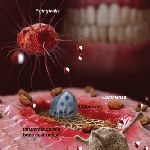PG菌はキーストーン種であるという論文(Porphyromonas Gingivalis as a Potential Community Activist for Disease)を紹介します。
リンデ臨床歯周病学の歯周感染症の章で『ポルフィロモナス・ジンジバリスは歯周病原菌そのものではなくて、キーストーン種となって歯周病を引き起こす』という仮説を立てていますが、その根拠となる論文です。
| Porphyromonas Gingivalis as a Potential Community Activist for Disease R P Darveau 1, G Hajishengallis, M A Curtis J Dent Res.2012 Sep;91(9):816-20. doi: 10.1177/0022034512453589. Epub 2012 Jul 6. |
歯周炎に関連する微生物としてはレッドコンプレックスと呼ばれる3種類の細菌が有名です。中でもプロフィロモナス・ジンジバリス菌はもっともよく研究されている微生物で、歯周炎の発症に深く関係していると考えられています。
しかし、P.ジンジバリスは炎症疾患を引き起こす細菌の特徴を備えていないというパラドックスがあり、歯周病原菌と考えれるのには少し無理があります。
そこで、この論文では
「P. ジンジバリスは共生歯周微生物群の組成や外観を変えることで、歯周炎を発症していると考えられ、P.ジンジバリスはキーストーン種であると考えられる」
という結論を引き出しています。

困惑する歯周病学者
この論文を読んで「なるほど」と無条件で納得する人はそれほど多いとは思えません。なぜなら、P.ジンジバリスの果たすキーストーン種としての役割があまりクリアではないからです。
長い間、レッドコンプレックス(P.ジンジバリスなど3種類の細菌)が歯周病原菌であると考えられてきました。
しかし、口腔内マイクロバイオータなど歯周関連微生物群に関して新しい知見が次々ともたらされ、特定の歯周病菌と歯周炎の発症、進行と結び付ける考え方からなかなか抜けきれずにいる歯周病学者は、新しい知見と従来の研究を統合するのに四苦八苦しているようにみえます。
ヒトマイクロバイオーム計画の報告は、歯周病と口腔内の細菌の関係に関して、新しい考え方を求めているように思えてなりません。
歯槽骨破壊は古い免疫系が引き起こす
私がこの論文で興味を持った箇所は、ジンジバリス菌がいても、免疫応答に変化があると骨吸収が起きないというところです。
ジンジバリス菌に骨吸収の要因があるとすれば、免疫の不備があろうが無かろうが、骨吸収とは関係しないのではないでしょうか。
免疫の不備で骨吸収がおきないということは、歯槽骨吸収は免疫システムとの関係が深いと考える方が自然です。
もっと言ってしまえば、好中球を含む自然免疫のシステムが歯槽骨吸収に大いに関係しているという仮説も成り立つわけです。
私は、歯槽骨破壊は共生微生物群の組成や量、ディスバイオシスなど細菌の要素に関係するのではなく、好中球の過剰の集積による古い免疫系の活性化により起こると考えています。(安保免疫論)
この安保免疫論に則った考え方の方が、歯周炎の発症、進行を明快に説明できるのではないかと思っているのですが・・・・(歯周病の新常識)

P.ジンジバリスはディスバイオシスを引き起こす
長年にわたる歯垢サンプルの広範な分析により、疾患と相互に強い関連性をもつ口腔細菌、レッドコンプレックスが同定されました。
その結果、これらの細菌は「歯周病原菌」と呼ばれています。
これらの細菌の1つであるポリフィロモナス ジンジバリスを用いた研究により、歯周組織の防御機構を妨害または調節するいくつかの機構が含まれていることが明らかになりました。
歯周炎のマウスモデルでは、P. ジンジバリスによる補体機能の調節が、正常なマイクロバイオータの量と組成の両方の大幅な変化を促進することが示されています。
この口腔共生微生物叢の変化が、マウスの病理学的骨量減少の原因となります。
こうして、P. ジンジバリスは、宿主と歯垢の間にディスバイオシスを引き起こし、これは歯周炎が開始されるメカニズムの1つであると考えられます。
それゆえ、P. ジンジバリスをキーストーン病原体と呼びました。
An extensive analysis of dental plaque samples over the years has led to the identification of "red" complex oral bacteria that have a strong association with each other and with disease. Consequently, these bacteria have been labeled 'periopathogens'. Studies with one of these bacteria, Porphyromonas gingivalis, have revealed that it contains several different mechanisms which either impede or modulate periodontal protective mechanisms. In a mouse model of periodontitis, it has been shown that modulation of complement function by P. gingivalis facilitates a significant change in both the amount and composition of the normal oral microbiotia. This altered oral commensal microbiota is responsible for pathologic bone loss in the mouse. Thus, P. gingivalis creates a dysbiosis between the host and dental plaque, and this may represent one mechanism by which periodontitis can be initiated. We have therefore termed P. gingivalis a keystone pathogen.
歯周炎の病因微生物
歯周炎は微生物の病因としての提案の十分な歴史があり、ソクランスキーによって雄弁に記述されています。
長年にわたって提示されたさまざまな仮説は、動物界のほぼすべての範囲から引き出された可能な病因を示唆しています。
この歴史は、多様な微生物群集と宿主の間の複雑な相互作用を理解することの難しさを強調しています。
しかし、口腔のサンプリングは比較的容易で非侵襲的であるため、健康と病気の両方で口腔内微生物群の包括的な分析を行うことができました。
他の調査結果とともに、これらの研究がレッドコンプレックスの同定につながりました。
3種類の口腔細菌– ポリフィロモナス ジンジバリス、タネレラ フォーシシア、およびトレポネーマ デンティコラ –の検出は互いに強く関連しており、病変部位と関連しています。
この画期的な研究と他の同時期の研究は、これらの細菌の潜在的な毒性因子の調査につながり、疾患との関連をより完全に理解しました。
P.ジンジバリスは長い間歯周病に関連しており、特徴付けられた個体群構造を有しており、重要なことにこれら3つの細菌の中で最も成長し、遺伝子操作しやすいため、最もよく研究されてきました。
Periodontitis has a rich history of proposed microbial etiologies, eloquently described by Socransky (Socransky and Haffajee, 1994). The varied hypotheses presented over the years have implicated possible etiological agents drawn from almost the complete range of the animal kingdom. This history underscores the difficulty in understanding the complex interactions between diverse microbial communities and the host. However, because of the relative ease and non-invasive nature of sampling the oral cavity, it has been possible to conduct comprehensive analyses of the oral microbiota in both health and disease (Socransky et al., 1998). Among other findings, these studies led to the identification of a “red” complex: 3 species of oral bacteria – Porphyromonas gingivalis, Tannerella forsythia, and Treponema denticola – whose detection was strongly associated with each other and with diseased sites. This landmark work and other contemporaneous studies (e.g., Curtis et al., 2011) naturally led to the investigation of potential virulence factors for these bacteria, for a fuller understanding of their association with disease. Since P. gingivalis has long been associated with periodontal disease, has a well-characterized population structure, and, critically, is the easiest of these 3 bacteria to grow and genetically manipulate, it consequently became the most well-studied (Lamont and Jenkinson, 1998; Curtis et al., 2001).
P.ジンジバリスのパラドックス
しかしながら、P.ジンジバリスを用いた研究は、炎症性疾患と強く関連する細菌が炎症の強力な誘導因子ではないという明らかなパラドックスを示しました。
たとえば、P.ジンジバリスのリポ多糖(LPS)は異常に低い炎症効力を明らかにし、実際、炎症を阻害するTLR4アンタゴニストとして作用するP.ジンジバリスの脂質A構造が発見され、特徴付けられました。
これらの驚くべき結果は、大腸菌や他の多くのグラム陰性菌から得られた、よく特徴付けられた非常に炎症性のLPSとは対照的なものです。
さらに、P.ジンジバリスは、他のさまざまな口腔細菌とは異なり、歯肉上皮細胞によるIL-8分泌を誘導せず、実際、好中球動員のためのこの強力なケモカインの分泌を阻害したという珍しい特徴もあります。
この現象は「局所ケモカイン麻痺」と呼ばれ、P.ジンジバリスは炎症性疾患の原因となる細菌に通常関連する特徴を示さないという新たな見方を強化しました。
最近では、P.ジンジバリスを用いた継続的な研究により、受容体クロストークメカニズムを通じて白血球からの炎症反応のレパートリーを選択的に誘導できるという点で、それは優れた免疫マニピュレーターであることが明らかになりました。
具体的には、白血球を介した細菌殺害メカニズムを阻害することができます。
しかし、これらの明らかな逆説は、歯周炎が、単一または複数の選択された周縁病原菌によって引き起こされる従来の感染症の従来の見方とは対照的に、機能不全の微生物叢全体に依存するコミュニティ病と見なされる場合に説明できます。
マニピュレーター;immune manipulator・・巧妙または悪質な方法で他者を制御または影響する人。
However, studies with P. gingivalis presented an apparent paradox in which a bacterium that was strongly associated with an inflammatory disease was not a potent inducer of inflammation. For example, the lipopolysaccharide (LPS) of P. gingivalis revealed an unusually low inflammatory potency, and, in fact, a P. gingivalis lipid A structure acting as TLR4 antagonist that inhibits inflammation has been discovered and characterized (Darveau et al., 1995). These surprising results stand in contrast to the well-characterized, highly inflammatory LPS obtained from Escherichia coli and many other Gram-negative bacteria (Munford and Varley, 2006). Furthermore, P. gingivalis was unusual in that it did not induce IL-8 secretion by gingival epithelial cells, unlike a variety of other oral bacteria and, in fact, inhibited the secretion of this potent chemokine for neutrophil recruitment (Darveau et al., 1998). This phenomenon was termed ‘local chemokine paralysis’ and reinforced the emerging view that P. gingivalis did not demonstrate characteristics normally associated with a bacterium contributing to an inflammatory disease. More recently, continued studies with P. gingivalis have revealed that it is an excellent immune manipulator, in that it is able to selectively induce only a limited repertoire of inflammatory responses from leukocytes through receptor cross-talk mechanisms (Hajishengallis et al., 2008; Liang et al., 2011). Specifically, it can inhibit leukocyte-mediated bacteria-killing mechanisms (Wang et al., 2010). These apparent paradoxes can be explained, however, if periodontitis is viewed as a community disease reliant upon an entire dysfunctional microbiota, as opposed to the traditional view of a conventional infectious disease caused by a single or even multiple select periopathogens (Hajishengallis et al., 2011).
P.ジンジバリスはマイクロバイオータに変化を与え骨吸収を促す
当初、共生微生物群集が歯周炎に大きく寄与している可能性があるという証拠は、細菌が定着していない無菌(GF)マウスと、通常の特定病原体フリー(SPF)のマウスにP. gingivalis強制経口投与して比較したときに得られました 。
SPFマウスとGFマウスの両方がP.ジンジバリスで口腔内に同程度にコロニー形成しましたが、骨量減少を発症したのはSPFマウスのみでした。
驚くべきことに、SPFマウスは定量的リアルタイムPCRに基づいて上顎あたり約100個のP. ジンジバリス細胞(50〜350の範囲、総細菌細胞の<0.01%を表す) が検出できたことは、共生微生物叢の変化において非常に有意義でした。
まず、P。ジンジバリスに感染したSPFマウスの口腔スワブのコロニー形成単位に基づいて測定された総微生物負荷は、約2 log10単位上昇しました。
第二に、この共生微生物叢の個体群構造に定性的な変化があり、一部の生物の検出が失われ、他の生物の外観が失われました。
P.ジンジバリスはGFマウスとSPFマウスの両方にコロニーを形成しましたが、SPFマウスのみが骨損失を発症し、口腔共生社会の大きな変化と相まって、P.ジンジバリスが共生または共生組成の微生物シフトを誘発したことを示しました。
さらに、GFマウスの疾患の欠如は、共生細菌自体がこのモデルで観察される骨量減少に必要であり、それに直接寄与していることを示していました。
Initially, evidence that the commensal microbial community may significantly contribute to periodontitis was obtained when the disease experience of germ-free (GF) mice, which are not colonized with any bacteria, was compared with that of normal specific-pathogen-free (SPF) mice in the well-established P. gingivalis gavage model (Baker et al., 2000). Although both SPF and GF mice were colonized in the oral cavity with P. gingivalis to the same extent, only SPF mice developed bone loss. Remarkably, though only approximately 100 P. gingivalis cells per maxilla (ranges from 50-350, representing < 0.01% of the total bacterial cells)/SPF mouse could be detected on the basis of quantitative real-time PCR, there was a very significant change in the commensal microbiota. First, the total microbial load measured on the basis of colony-forming units in oral swabs of P. gingivalis-infected SPF mice rose by approximately 2 log10 units. Second, there was a qualitative shift in the population structure of this commensal microbiota, leading to loss of detection of some organisms and the appearance of others. The demonstration that P. gingivalis colonized both GF and SPF mice, yet only SPF mice developed bone loss, coupled with the significant changes in the oral commensal community indicated that P. gingivalis induced dysbiosis, or a microbial shift in the commensal composition. Furthermore, the lack of disease in GF mice indicated that the commensal bacteria themselves are necessary for and directly contribute to the bone loss observed in this model.
共生微生物群が歯槽骨の吸収をもたらす
2つの独立した実験的アプローチにより、経口共生細菌がマウスの骨量減少に直接関与していることが確認されました。
当初、GFマウスは、系統および年齢が一致したSPFマウスと比較して、大幅に多くの歯槽骨を持っていることが観察されました。
歯槽頂とセメント-エナメル接合部との間のギャップを決定するこれらの測定値は、GFマウスでは小さめでした。
共生微生物群が骨量減少を引き起こす最初の実験的証拠は、GFマウスではなく、SPFが歯槽頂とセメントエナメル質接合部との間の距離が増加することが実証されたことです。
この「自然な」骨量減少は、GFマウスのそれと比較して、SPFの口腔組織における多数の炎症性メディエーターの増加と関連しており、共生微生物が歯周組織を自然に刺激することを示し、これはいくつかの非病的骨量減少をもたらします。
2番目のアプローチは、SPFマウスと一緒にケージに入れられたGFが口腔共生微生物群を獲得して骨量減少をもたらすことを示しました。
これらの実験では、2週間同一のケージに入れらた後、GFマウスはSPFマウスと同じ口腔内微生物叢を獲得し、16週間後にGFマウスはその菌株と同様のレベルまで骨を失ったことが判明しました。
これらのデータの分析は、マウスの骨量減少が共生コロニー形成の自然な結果であり、宿主とその口腔微生物群集の間の恒常性の関係の現れであることを示しました。
Two independent experimental approaches confirmed that oral commensal bacteria directly contribute to bone loss in the mouse. Initially, it was observed that GF mice have significantly more alveolar bone when compared with strain- and age-matched SPF mice. These measurements, which determine the gap between the alveolar crest and the cement-enamel junction, were less in GF mice. The first experimental evidence that commensals cause bone loss was the demonstration that as the SPF, but not the GF, mouse ages, the distance between the alveolar crest and the cement-enamel junction increases. This “natural” bone loss was associated with an increase in numerous inflammatory mediators in the oral tissues of SPF compared with those of GF mice, indicating that commensals naturally stimulate periodontal tissue, and this results in some non-pathologic bone loss. The second approach demonstrated that the acquisition of oral commensals by GF that have been co-caged with SPF mice resulted in bone loss. In these experiments, it was determined that after 2 wks of co-caging, GF mice had acquired an oral microbiota identical to that of SPF mice, and after 16 wks, the GF mice had lost bone to levels similar to those of their strain-matched SPF cage-mates. Analysis of these data demonstrated that bone loss in the mouse is a natural result of commensal colonization and represents a manifestation of the homeostatic relationship between the host and its oral microbial community.
骨の減少には補体が必要
次に、共生微生物群の定着によって誘発される自然の骨量減少には補体が必要であることがわかりました。
C3aまたはC5a受容体(C3aR-/-またはC5aR-/-)のいずれかが欠損しているSPFマウスは、系統および年齢が一致する野生型コントロールよりも歯槽骨が多いという点で、GFマウスと同様に見えました。
さらに、P。ジンジバリスがこのマウスモデルで骨損失の加速を引き起こすメカニズムの1つは、共生口内微生物叢と補体系の恒常性の関係を破壊することであることがわかりました。
C.aR-/-またはC5aR-/-マウスは、P。ジンジバリスによる強制経口投与後に、骨を失うことも、共生口腔細菌数に有意な変化を示すこともありませんでした。
P.ジンジバリスは、補体のジンギパイン依存性タンパク質分解性開裂およびその後の白血球細胞表面でのクロストークを介して宿主補体系を操作できるという以前の観察と一致しており、歯肉欠損性P.ジンジバリス株(rgpA-/-、rgpB-/-、kgp-/-)はまた、骨量減少を誘発したり、口内共生微生物叢を増加させることができませんでした。
したがって、P。ジンジバリスは補体機能を変化させることにより、共生宿主のホメオスタシスの対話を調整できると思われる。
この変調は炎症と骨破壊を増加させます。
P.ジンジバリスによる6週間のコロニー形成後の若いSPFマウスに見られる骨量減少は、18ヶ月齢の未処理SPFマウス(すなわち、P。ジンジバリスを接種していない)に見られる骨量減少と同等であると推定されました。
Next, it was found that the natural bone loss induced by commensal colonization required complement. SPF mice deficient in either the C3a or C5a receptor (C3aR-/- or C5aR-/-) appeared similar to the GF mice in that they had more alveolar bone than their strain- and age-matched wild-type controls. Furthermore, it was found that one mechanism by which P. gingivalis induces accelerated bone loss in this mouse model was by disrupting the homeostatic relationship between the commensal oral microbiota and the complement system. C3aR-/- or C5aR-/- mice neither lost bone nor displayed a significant change in the number of commensal oral bacteria after gavage with P. gingivalis. Consistent with earlier observations that P. gingivalis can manipulate the host complement system through the gingipain-dependent proteolytic cleavage of complement and subsequent cross-talk on the leukocyte cell surface (Liang et al., 2011), a gingipain-deficient P. gingivalis strain (rgpA-/-, rgpB-/-, kgp-/-) also failed to induce bone loss or increase the oral commensal microbiota. Therefore, it appears that P. gingivalis can modulate the commensal-host homeostasis dialogue by altering complement function. This modulation increases inflammation and bone destruction. It was estimated that the bone loss seen in young SPF mice after 6-week colonization by P. gingivalis is equivalent to the bone loss seen in untreated SPF mice (i.e., not inoculated with P. gingivalis) at 18 mos of age.
免疫不全の場合P.ジンジバリスが骨量減少を誘発することはない
最後に、これらの研究は、宿主の免疫不全が口腔共生微生物叢との恒常性の関係を変化させた場合、P.ジンジバリスが骨量減少を誘発することがないことを示しました。
たとえば、好中球白血球インテグリンLFA-1の欠如、またはケモカイン受容体CXCR2の欠如のいずれかが原因で、接合部上皮への好中球ホーミングが不足しているマウスは、野生型対照株と比較した場合、口腔共生微生物叢の増加を示し、有意な骨を発達させました。
実際、LFA-1-/-マウスの骨量減少は、これらのノックアウト動物の口内共生細菌数の増加と相関しており、抗生物質を投与した場合、この骨量減少は発生しませんでした。
これは、抗生物質の投与により無効にされた野生型マウスと比較して、経口微生物量の増加と骨損失の増加と同じ効果を示した、P-およびE-セレクチンダブルノックアウトマウスのはるか以前の出版物と同様です。
これらのデータの分析は、いくつかの異なるメカニズムによる歯周ホメオスタシスの破壊が骨量減少につながる可能性があることを示したが、共生微生物叢の寄与が共通の要因であるように思われる。
Finally, these studies (Hajishengallis et al., 2011) demonstrated that P. gingivalis was not necessary to induce bone loss when immune deficiencies in the host altered the homeostatic relationship with the oral commensal microbiota. For example, mice deficient in neutrophil homing to the junctional epithelium, because of either the lack of the neutrophil leukocyte integrin, LFA-1, or the absence of the chemokine receptor, CXCR2, displayed an increase in the oral commensal microbiota and developed significant bone loss when compared with their wild-type control strains. In fact, the bone loss in LFA-1-/- mice was correlated with an increase in the numbers of oral commensal bacteria in these knock-out animals, and this bone loss did not occur when antibiotics were administered. This is similar to a much earlier publication in P- and E-selectin double-knockout mice which showed the same effect of an increased oral microbial load and increased bone loss, compared with wild-type mice, which was abrogated upon the administration of antibiotics (Niederman et al., 2001). Analysis of these data demonstrated that disruption of periodontal homeostasis by several different mechanisms can result in bone loss, but the contribution of the commensal microbiota appears to be a common factor.
P.ジンジバリスをキーストーン種とする
P.ジンジバリスは存在量が少ないにもかかわらず、口腔内微生物叢の量と組成の両方に非常に大きな影響を及ぼし、歯周炎を引き起こしたという事実に基づいて、この細菌を「キーストーン」種に指定しました。
キーストーン種の概念は、生態学的研究に由来し、存在量が少ないが、生態系コミュニティ全体に主要な支援的役割を提供する種として定義されています。
疾患に関連したマウスの口腔内微生物叢の大幅な増加には、P.ジンジバリスの少量の継続的な存在が必要であることを実証できました。
さらに、P.ジンジバリスは「キーストーン病原体」、つまり、病因も促進する方法で微生物群集をサポートおよび改造するキーストーン種と見なすことができます。
Based upon the fact that P. gingivalis was present in low abundance yet had such a profound effect on both the amount and composition of the oral microbiota, leading to periodontitis, we have designated this bacterium a “keystone” species. The concept of a keystone species derives from ecological studies and is defined as a species that is present in low abundance yet provides a major supporting role for an entire ecological community (Paine, 1969; Power et al., 1996). We were able to demonstrate that the continued presence of low numbers of P. gingivalis was required for the significant increase in mouse oral microbiota which was associated with disease. Moreover, P. gingivalis could be viewed as a ‘keystone pathogen’, that is, a keystone species which supports and remodels a microbial community in ways that also promote disease pathogenesis .
| 歯周病の新常識 小西昭彦 阿部出版 |
歯科治療の新常識 小西昭彦 阿部出版 |

